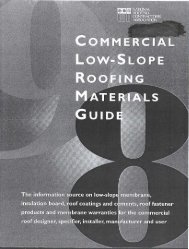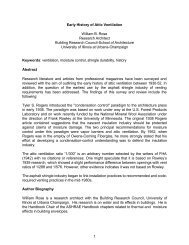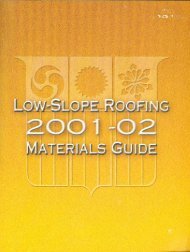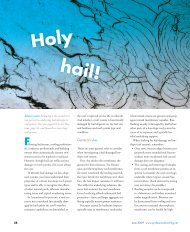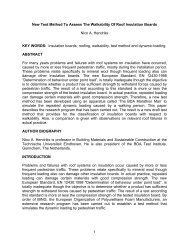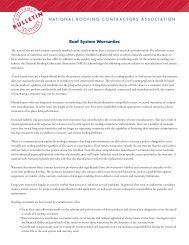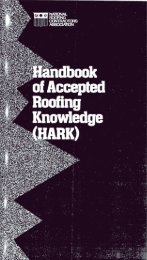! j I I - National Roofing Contractors Association
! j I I - National Roofing Contractors Association
! j I I - National Roofing Contractors Association
- No tags were found...
Create successful ePaper yourself
Turn your PDF publications into a flip-book with our unique Google optimized e-Paper software.
Information on Roof MembranesBUILT-UP BITUMINOUS MEMBRANES 2. Non-Vulcanized Elastomers .-\Iso referred to as "uncuredelastomers"-are not physically cured during manufacture.I A built-up bituminous membrane is the continuous semiflex- However, they may cure or vulcanize naturally over someible component of a roof system with the primary function period of time, upon exposure to the elements. Once theyof excluding water. The membrane consists of two or more have cured, their behavior is similar to that of the vulcanizedalternate plies of felts, fabrics, or mats that are often saturat- elastomers, and they have become thermosets.. .. ermop astlC matena Istmguls e 110m t ermosetsed and sometimes coated with bituminous materials, assem- 3 Th I . . Is D .. . h d £..hbled In place, and adhered to each other with alternate layers ' h h . I . k . I ... .. m t at t ere IS no cross- m mg or vu camzatlon-can be weofbItumInous products. Surfacing and parts of the substrate d h ' h h I d d Ild.. e toget er WIt eat or so vent an eve op In t hese we ld~are not consIdered components of the membrane.SINGLE-PLY ROOFING MEMBRANE MATERIALSb on d strengt h stat h equa I or surpass t h e strengt h 0 f tease h bmaterial.4. Modified Bitumen roofing membranes Composite sheetsconsisting of bitumen, modifiers, and reinforcement. TheThe following information is reproduced from Single-Ply Roof term "modified bitumen" encompasses a broad range ofing: A Professional~ Guide to Specifi~ations, with the approval materials, and each specific material differs from the othersof the Single-Ply <strong>Roofing</strong> Institute (SPRI). with respect to the modifiers and reinforcements used. TheyThe synthetic materials that are used today as single-ply exhibit the thermoplastic quality of being softened by heat,roofing membranes have a long history of use in other types but are separated into their own generic category becauseof products; for example, synthetic rubber sheeting has been of the significant differences in their chemical makeup fromused to make tarpaulins and tires, and vinyl products have the other thermoplastic materials.been used for window framing and exterior siding. The specificformulations of these materials are determined by the waythey will be used. Materials that are to be used as sheet-applied GENERIC PRODUCT TYPESroofing membranes must be formulated to exhibit certaincharacteristics that make them suitable for that purpose. Recognizing that no two products are identical even if theyThe function of a roof membrane is to provide a water- consist of the same predominant polymeric composition, thetight c6vering for a building. It must be durable, strong, and following descriptions provide some general informationresistant to climate and weathering. It must be able to accom- about each generic product type.modate anticpated structural movement without splitting or .cracking. And, it must retain all of these properties over a Vulcanized Elast~mers '. .reasonable period of time. 1. EPDM EPDM IS an elastomenc compound synthes~zedIn order to formulate materials that meet all of these re- from ethylene, propylene, and a small amount of dlenequirements, the proper mix of ingredients must be used. The mono.mer. It is ge.n~rally used. for roofing as a vulcanizedmaterials' properties must be consistent from batch to batch. matenal, although It IS also ~osslble to formulate EPDM me~-Manufacturers adhere to strict quality control programs to ?ranes th~t are non-~ulcamzed. Used as a roofing materialensure that minimum physical properties are achieved and m the UnIted States sInce the early I 960s, EPDM sheets rangemaintained in thickness from 30 to 60 mils and are usually black or white. in color. EPDM membranes exhibit a high degree of ozone,Products being used today for single-ply roofing ultraviolet, weathering, and abrasion resistance and good lowmembranestemperature flexibility. EPDM's properties of resilience, ten-The list is long and growing, and the chemistry is complex. ~ile s~rength, elongation, and hardness are ~argely ~etainedFrom a purely chemical point of view, all of the assorted In aging ~ests at ~levat~d temperatures. R~slstance IS excelmaterialscan be labeled "polymeric," meaning "macro. lent to acIds, alkalIs, anImal and vegetable oils, and oxygenatmolecularmaterial formed by the chemical combination of ed solvents, such as ketones., esters, and alcohols. O~ the.othermonomers having either the same or different chemical com- hand, exposure to a~omatlc, halogenated: and allp~atlc ~olposition"("Terminology Pertaining to Elastomeric and Plasto- vents should be avoided to prevent swelling and distortionmeric Material," the <strong>Roofing</strong> Industry Educational Institute, of the membrane.1981). 2. Neoprene Neoprene, or chloroprene rubber, is the first. commercially available synthetic rubber product. NeopreneThe four groups of single-ply products is formulated from polymers of chloroprene that were ini.Defined by their chemical nature, they are: tially developed by E.I. DuPont de Nemours and Company,1. Vulcanized Elastomers Also refered to as "thermosets." which has been manufact~ring ne.oprene products ~ince 1~31.Both terms relate to the chemical cross-linkage of the poly- ~eoprene may be used In a varIety ~f elastomenc apphca.mers, which occurs during the manufacturing process. Once tlons. I! can be molded or ext~ded 1n~0 hose, belts,. heels,the linkages have been formed, a process also termed "cur- s?les, tIres, gaskets, coated fabrIcs, or wI~e and .cable Ins~laing,"they cannot be changed. A distinguishing characteristic tlon. Neopren~s are also used to make qulck-settln~ and hIghofa vulcanized elastomer is that it can only be bonded to strength a?hesl,ves. Neoprenes may be cal~ndered.In.t°.shee~sitself (for example, to seam overlapping sheets) by the use that vary In thlcknes~ from 30 to 120 mIls, and It IS In thisof an adhesive because once cured new molecular linkages form that neoprene IS used for roofing membranes. Chlocannt be formed" roprene synthetic rubber sheets have been used as a single-0 . ply roofing membrane since 1957. Sheets are available plain;~ -J-- :,;~=" 15


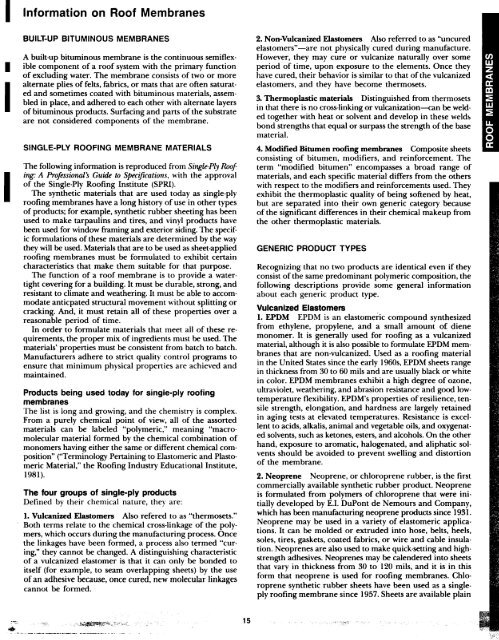

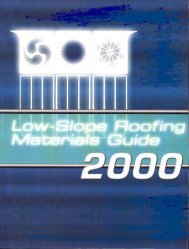
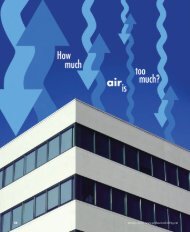

![Wm] - National Roofing Contractors Association](https://img.yumpu.com/36696816/1/190x245/wm-national-roofing-contractors-association.jpg?quality=85)

